 A simple dish inspired by Sardinia Italian regional cuisines, no matter how different, are united by the common spirit of highlighting the best bounty of the region and of the season. Such is true up to the peripheries of the country - i.e. the non-peninsular island regions of Sicily and Sardinia, both of which are famous for good food inspired by other cultures they've come into contact with. It's been almost a year now since I've been to Sardinia and I came back from there taking home this bag of curious couscous-like porous pasta - la fregola - one of the islands specialties. I remember being served this curious pasta paired with a nice seafood ragù - ever wondering whether it's pasta or a whole grain (with other Italians on the table wondering as well). This is the spirit of the dish I tried to recreate today. Being here in Naples inspired the concept of using just vongole verace which works perfectly well with spaghetti and I chose to use a semi-soffrito of garlic and bell pepper as base (a bit of a Spanish thing). Ingredients: 400-450g of Fregola (serves 3) 500g of Vongole Verace or Medium-sized Clams 5-6 Cloves of Garlic 1 Bell Pepper, sliced or chopped Green Beans, about 10-12 pieces, top and tail-trimmed and cut into two pieces Cherry Tomatoes, about 8-10 pieces, halved Olive Oil White Wine Parsley Chili Flakes (optional though I recommend it, about 3 tsp. or 1 tbsp.) 1. The flavor base of this dish is a garlic oil made by heating extra-virgin olive oil (very low heat) and adding in some crushed and chopped cloves of garlic into the oil, allowing the garlic to slightly brown and infuse its flavor into the oil. When the garlic has sufficiently browned, add the chili flakes (optional, but I really recommend it as the spicy kick is nice with the seafood). 2. Add the sliced bell pepper and sauté until soft. While peppers are cooking, one can also add the cherry tomatoes, blistering them in the hot pan (crank up the heat a bit) as well as the green beans. 3. When the vegetables are about half-cooked (not totally done as they will continue to cook), add in some white wine and stir a bit to lift the caramelized bits on the pan. Add the fregola and add some more water (vegetable stock is an option for enhanced flavor but I find that the flavors can sufficiently develop without this). 4. The fregola must be cooked risotto-style in the pan - which means adding water (normally, hot stock) in parts and not all together in one go and letting the pasta absorb it and cook before adding some more. Let the pasta and vegetables cook thoroughly this way, tasting the texture of the pasta at each step. 5. When the pasta is significantly cooked - i.e. with some resistance but still shy of al dente, time to add the clams on the pasta and let them steam open, releasing their flavors into the dish. Continue adding water in the process as the further cooking may burn the pasta and hot water will steam to accelerate the opening of the clams. When all have opened (some stubborn ones might remain but those are probably the bad ones - I seldom get them here in Naples), the dish is ready. 6. Chop up some parsley coarsely (stalk and all) and mix into the dish before serving. Plate up the pasta at the bottom of the dish and the pasta-coated clams on top. Be generous and don't put cheese!.
Basing on their reaction, both my new chinese housemate and my visiting friend seemed to like it and the flavors are simple and good if nailed. I myself loved the dish and this is probably one I'll repeat again to showcase regional Italian cooking to other friends and visitors - next time, I'll try to make fregola by hand though (I've seen videos in youtube and it seems easier than making pasta!)... Buon appetito! | |
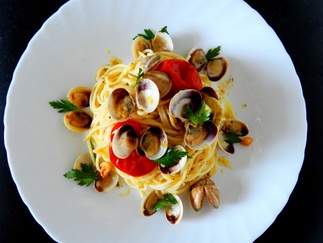 Italian food, as I have learned from observing, is really about the ingredients which should be seasonal, local and fresh and, when treated with respect, should yield delicious dishes that can be perfectly enjoyed.
Being in Naples, which has one of the most picturesque coastlines in the entire Italian peninsula, I got to see the intimate relationship of this city to the sea and how this has been so important in its history and how this also figures into the city's food culture which is rich and captivating.
As far as pasta dishes are concerned, in my opinion, it doesn't get any more Napoletano than spaghetti alle vongole (or spaghetti with clams) - it requires no more than a few ingredients, the focal point of which is the clams (of which there are different options in size and shape)... a local pride.
Ingredients:
Pasta, preferably spaghetti or any other thin strand pasta (250g makes about 3 servings)
Clams (about 300-400g)
Olive Oil
Garlic (about 3-4 cloves)
Tomatoes (optional, preferably cherry tomatoes)
Chili Flakes or Chili Powder (optional)
Parsley
1. Boil water for cooking the pasta. Once boiling cook until al dente (or "to the bite"). Package time is only a guideline - unless you're an expert, I believe trying the pasta is the only way to really perfectly cook it. Drain and prepare to add into the sauce (which should be ready by the time the pasta is cooked).
2. Make the base of the sauce which is simply an aglio e olio (garlic and oil). Heat some olive oil at low to medium heat, add the chopped cloves of garlic and lower the heat to prevent the garlic from browning rapidly - you want to draw out the garlic flavor and let it infuse into the oil.
3. If adding tomatoes and chili, time to add them to the garlic oil. If using cherry tomatoes, blister them into the pan and squash them (rather than pre-cutting them before cooking) as the juice enriches the sauce and the tomatoes become sweeter when "kissed by heat".
4. Add the clams and cook them until they all open up (normally, everything opens up but if after a long time, some stubborn ones that don't remain, they are probably bad so simply discard them). Some recipes would add white wine in this point (sometimes I do, sometimes I don't) but, following the direction of simplicity, one can omit that. Should you choose to use wine, use a dry white wine (here in Italy, I really just tend to choose locally). If very little oil remain in the pan, add some more olive oil (as this will be an essential part of the sauce).
5. Once both sauce and pasta are prepared (if the clams finish before the pasta, reduce heat... you don't want to overcook the clams), add the pasta into the sauce and mix thoroughly making sure that the sauce coats the pasta. Add some chopped parsley and plate up - pasta underneath and trying to put most of the clams on top to "showcase" them. Add more parsley and DON'T ADD CHEESE! Cheese and fish is an italian no-no (though there are known exceptions like tonnarelli, cozze e pecorino, in Rome) and I tend to agree, for the most part. In case lacking in salt, correct by sprinkling some fine salt into the dish (this happens though it's really safer to never add more salt into seafood while cooking as it could easily become too salty).
I find that clams are one of the best seafood one can really get to try here in Naples along with other shellfish like mussels (I'm craving for an 'mpepata di cozze or "peppered mussels" now) as well as things like shrimps, octopus, squid and cuttlefish. All of these would have classical ways of preparing them according to Neapolitan tradition and all most all would figure in Christmas Eve meals which, in Southern Italy, is known as the Festa del 7 Pesce (Feast of the 7 Fishes, corresponding to the tradition of having 7 different fish courses) which is still in practice up to present (I've never been in one since I celebrate Christmas either in Rome or elsewhere). Cucina napoletana also boasts of having various pastries and dessert pieces that provide scrumptious finishes to each meal (but as I'm not a strong baker, I can't exactly make them!). This rich tradition that matches the rich local history (dating up to the ancient Greeks) makes Naples one of the most special places to live in and visit in Italy.
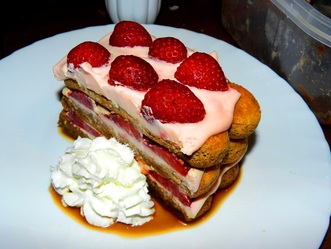 Yes, I know you're salivating! Tiramisu is one of those classic Italian desserts that every tourist wants to have in Italy and that, luckily, every Italian knows how to make (probably). It's so simple yet so good and luscious that it's really hard to get it wrong so every home cook should be able to make one... yes, it's soooo SIMPLE!
Ingredients:
Savoiardi (Italian lady finger biscuits)
Espresso (or, for those outside of Italy, the strongest coffee that you can get), unsweetened
Mascarpone (which is a creamy Italian cheese used in desserts), 250g
1 Egg (or 2 Egg Yolks)
Sugar
Optional Stuff:
Coffee Liquor (makes the dessert richer and gives that extra sexy kick)
Strawberries (or other fruits which you could cut into segments and used to pretty up the dessert like cherries, berries or orange segments)
Cinnamon or Nutmeg or Cocoa Powder
And you need a nice plastic container for the dessert which you can put in the fridge (me? I wash and re-use old ice cream containers).
Making tiramisu is not rocket science... The idea is to make a layered dessert made from the lady fingers soaked in coffee with the mascarpone cream in between...
1. Best to start with the mascarpone cream... Add some sugar into the egg/egg yolks and whip them until slightly foamy/airy. I normally use just the entire egg (else, what do I do with the whites) but I guess some people just use egg yolks (and seeing how yellow some mascarpone creams are, they probably do use just the yolks). Add about half of the mascarpone and whip until full incorporated and then add the other half and whip some more. Taste - if not sweet enough, add more sugar. (And, in case you're wondering, I made the cream pink by adding some KoolAid powder...)
2. The 250g+ mascarpone mix should be good enough for about 4 layers of savoiardi with 6 pieces each layer. You need to soak this into some unsweetened espresso (or the strongest coffee you can make) so make enough coffee. You can also spike it with a bit of coffee liquor (though not so much) or rum.
3. Don't soak all the fingers at the same time! Soak them one at a time, never letting them stay too long into the liquid (or they'll bloat up and turn to mush... they're really porous!), and placing them carefully into your clean plastic container. After a layer is done, spread some of the mascarpone-egg mix... Make another layer, put more cream, make another layer, put more cream... until you fill the container (or you run out of either mascarpone mix or savoiardi). In case you are using some fruit (like halved strawberries as in the example above), place the fruit on top of the cream - this will prevent them moving.
4. Add some cinnamon or nutmeg or cocoa powder at the top as a final flourish (if you wish).
5. Refrigerate the assembly for about half an hour, letting the cream set for a bit. Afterwards, serve and enjoy!
For non-bakers like me, being able to make a dessert like this is such a treat since I'll be able to serve up an entire meal that I cooked by myself to friends and family, if i wanted to... So yeah, another recipe to add to your repertoires!
 Ending my blog break by posting this simple recipe for a classic Roman pasta dish (which I just had for lunch)... perfect for grad students, young professionals and other people living alone (just like me). Ingredients: Pasta, preferably spaghetti or bucatini (250g makes about 2 servings) 1 Onion (medium-sized), chopped 100g of Pancetta or Bacon ( Guanciale, if you can get some) Passata di Pomodoro (Tomato puree or Tomato sauce, unflavored) Black Pepper (and chili, if you want) Pecorino Romano (or Parmigiano-Reggiano, if it's easier to get) 1. Boil water for pasta. Once boiling, add the pasta and cook till al dente (follow the time written in the package only as a guideline - tasting is better). Drain the pasta - to be added to the sauce (which should be finished at more or less the same time the pasta is cooked). 2. While the pasta is cooking, render the fat and crisp up the pancetta in a non-stick pan with a touch of olive oil or butter (as necessary) at low heat. 3. Raise the heat to medium and add the chopped onion to the pancetta and sweat it out for a bit. Once translucent add some tomato puree/sauce and let it simmer for a bit. This is also the time to add bits of chili if you want ( sriracha or Thai hot sauce works for me). 4. Once the pasta is done, add into the sauce, mix thoroughly at low heat - letting the pasta cook for a bit more and letting the sauce penetrate. 5. Season the pasta with black pepper, plate it up and shave some pecorino romano on top (be generous!). Garnish with some fresh herbs (parsley or basil) if available. Like carbonara, 'matriciana (the way the Romans would call it) is one of those simple classic Roman/Lazio dishes centered on cured pork (guanciale or pancetta), understated but could be really tasty... Ideal for the lone graduate student too and good enough for a quick lunch or dinner during the weekdays or as an after drinking midnight snack during the weekends. Buon appetito!
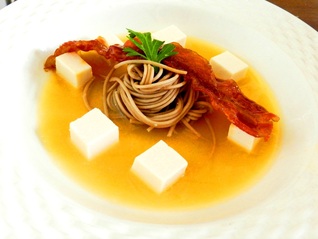 I love Japanese food - having spent almost a month and a half in Japan, I've seen it's range and potential, it's simplicity in flavor combinations and its elegance demonstrated in technique.
Coming how to a fridge with not a lot of stuff (but indeed a few Japanese-related ingredients), I decided to have a crack at making a Japanese-inspired dish myself.
Ingredients:
Tofu (silken/medium)
Miso soup paste
Buckwheat Soba
Bacon, strips
Soy sauce
Sugar
1. Prepare your miso soup: since I don't have other options (being that I live in Italy), I used miso soup paste and added it with some water and brought it up to a boil - voila! Instant miso soup (misoshiru).
2. In a non-stick pan, lay out your bacon strips and render the fat out of the bacon. If you are preparing a lot of bacon strips (and I suggest you do!), do this is batches making sure that each strip has maximal contact with the pan. After sometime, flip the strips to evenly cook both sides. Once the fat has rendered out (i.e. the opaque fatty part has turned translucent and fat has been released in the pan), remove the strips and do some more. You can use the remaining fat in the pan for other dishes (this is essentially "bacon essence") or let it become part of the sinful glaze we'll put in the bacon.
3. Put all of the rendered bacon strips in the pan. In a small container, mix one tbsp. of soy sauce with about half a tbsp. of sugar. Add just a small amount of water to help in the mixing. Raise the pan heat to high and pour this soy syrup on the bacon strips and let the syrup caramelize lightly and form a nice sticky glaze on the bacon strips. Don't let the caramel go too far out (it's gonna get bitter) and once the liquid gains viscosity and starts to bubble, turn of the heat.
4. Prepare the tofu and the soba: blanch the buckwheat soba in the hot, simmering soup - let it stay in the liquid for a couple of minutes, drain and shock with cold water. Cut up the tofu into cubes and add into the miso soup. Turn off the heat and let the tofu cook in the residual heat.
5. Plating up: Place tofu cubes neatly around the soup dish. Get the drained soba and twirl it into a neat bundle and place in the middle of the soup dish. Pour some misoshiru into the dish - just enough to cover about half of the tofu cubes. Place the bacon on top of the soba bundle. Top with a leaf of parsley.
Japanese-style clean flavors but with a rich (slightly unhealthy) twist.
Itadakimasu!
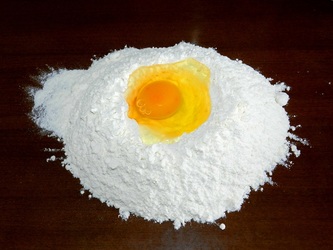 Looks simple? Not really! One of my the shows that I'm watching that really triggers me to expand my cooking repertoire is Masterchef Australia. The show is unbelievably entertaining (Mehigan and Calombaris make for some nice characters in the kitchen) and the idea of amateur cooks (a bit like myself) just putting themselves out there to build a career in food is just great.
In such shows, it seems like that people are expected (unreasonably, in my opinion) to be able to make past from scratch even if, in reality, most Italian restaurants (including those here in Italy as well) use dry pasta. I mean, okay, if you want to make custom-made ravioli or tortellini where you can put your own stuffing (like crazy ones like fish or egg yolk), clearly you have to roll out your own pasta but for other things ranging from lasagna to fettucini, the store-bought dry variety should be sufficient (especially if you live in Italy anyway since even the cheapest of packaged pasta is still of high quality).
In fact, not that I have seen a lot of other italians cook, but I've never heard of people making their own pasta (save for maybe grandmothers cooking for a special Sunday lunch) though it could also be regional (I've had a friend say that her friend from the Emilia-Romagna region [held to be the most foodie of all the regions] rolls out her own pasta every now and then, as her grandma taught her). That being said, I can't really go away from Italy never having tried to do this (if I'm gonna try to do this right, why not while I'm in Italy... maybe the air or the spirit will help me) so I decided to give it a go - I was hoping that the skill will come in useful for making my own gourmet ravioli or for making gnocchi from things other than potato.
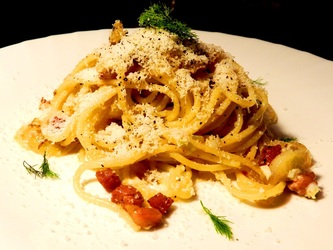 While I've known what real carbonara is even before coming to Italy (hint: no cream!), I didn't really get to fully appreciate the beauty in it's simplicity till I got here and tried to make one for myself (it's a no-brainer really) and it's one of those classic 5-ingredient Italian sauces you can put together in a jiffy for pasta - perfect for the hungry young professional/grad student.
Ingredients: Pasta, preferably spaghetti (250g makes about 2 servings) 1 Onion (chopped) 100g of Pancetta (or Guanciale, if you can get some) 1-2 Eggs (beaten) Black Pepper Pecorino Romano (or Parmigiano-Reggiano, if it's easier to get)
1. Boil water for pasta. Once boiling, add the pasta and cook till al dente (follow the time written in the package only as a guideline - tasting is better). Drain the pasta - to be added to the sauce (which should be finished at more or less the same time the pasta is cooked). 2. While the pasta is cooking, render the fat and crisp up the pancetta in a non-stick pan with a touch of oil or butter (as necessary) at low heat. 3. Raise the heat to medium and add the chopped onion to the pancetta and sweat it out for a bit. Once translucent, lower the heat to low and wait for the pasta to cook. 4. Once the pasta is done, add into the sauce, turn of the heat and add the beaten egg/s and mix thoroughly. The residual heat should be sufficient to slightly cook the egg but it's really this semi-cooked egg that gives the creaminess to the dish. 5. Season the pasta with black pepper, plate it up and shave some pecorino romano on top (be generous!). Garnish with some fresh herbs (parsley rather than basil) if available.
The dish (along with spaghetti all'amatriciana - which has tomato, onion and bacon as basis of the sauce) is a classic Lazio dish (Lazio is the region of the Italian capital city, Rome)... hence, the preference of using Pecorino Romano (sheep's milk cheese) over the more popular (at least abroad) parmesan. The salty cheese should be more than sufficient in adding salt content to the dish. The slightly raw egg provides the natural creaminess to the dish (and to put cream in it was probably started of by the French or the Americans). There are other Italian sauces which may have cream as well as other stuff like peas, mushrooms or broccoli and which probably have been mistaken before as "carbonara" but the original is really just plain and simple. This simplicity is typical of the real peasant fare that Italian food evolved from and it is this understated aspect is what makes Italian food so good for me.
Some notes: pasta dishes in Italy is always cooked to order (with a few exceptions, like pasta al forno - baked pasta) so cook it only when ready to eat it (never make pasta wait). Pasta quality is best while warm, after cooking, and problems really start when you let it wait either in the water (without draining, the pasta will swell too much and become soggy) or on a plate (unsauced, the pasta will dry out and stick together). I think this started these myths of putting oil in the water so the pasta won't stick together, etc. but, really, Italians don't do that. They just cook pasta to order and always al dente and all is well in the world!
 A nice quick and simple recipe for those who want ready lunch with clean flavors. Pedro Jimenez is a sweet and somewhat richly-flavored wine from Malaga in the southern Spanish region of Andalucia - I took home a bottle from my trip there last Easter and decided to open it as I couldn't get enough of Spanish flavors. I find that a simple reduction sauce made with it and shallots go really well with fish.
Ingredients:
Fish fillet (in this case perch)
Pedro Jimenez (or any other sweet Spanish wine)
2 Shallots, chopped
Corn Kernels, Shaved Fennel or any other light spring vegetable
Lemon Juice
Butter
Salt and Pepper
Parsley (for garnish)
1. Cut the fish fillet in to portions and marinade in some lemon juice for a few minutes.
2. Heat about 2 tbsp. of butter in a pan under low heat. Once fully melted, add the shallots and caramelize lightly.
3. At medium heat, sear the fish in the pan (skin side down, if using portions with skin) for two minutes on each side (or until done). Season with salt and pepper.
4. Remove the fish, turn the flame to high and deglaze the pan with Pedro Jimenez. Other sweet wines, particularly Spanish wines from the south such as sherry (Jerez) will also work well. Lower the temperature after the initial boil of the liquid and reduce the sauce until it has the viscosity of a nice glaze.
5. Plate up and serve the fish with rice, corn kernels (or any other spring vegetables such as fennel), some parsley and the Pedro Jimenez reduction on top. Enjoy.
Lightly tart fish, sweet and savory sauce and fresh veggies tickle my taste buds. Simple and easy cooking!
|








 RSS Feed
RSS Feed